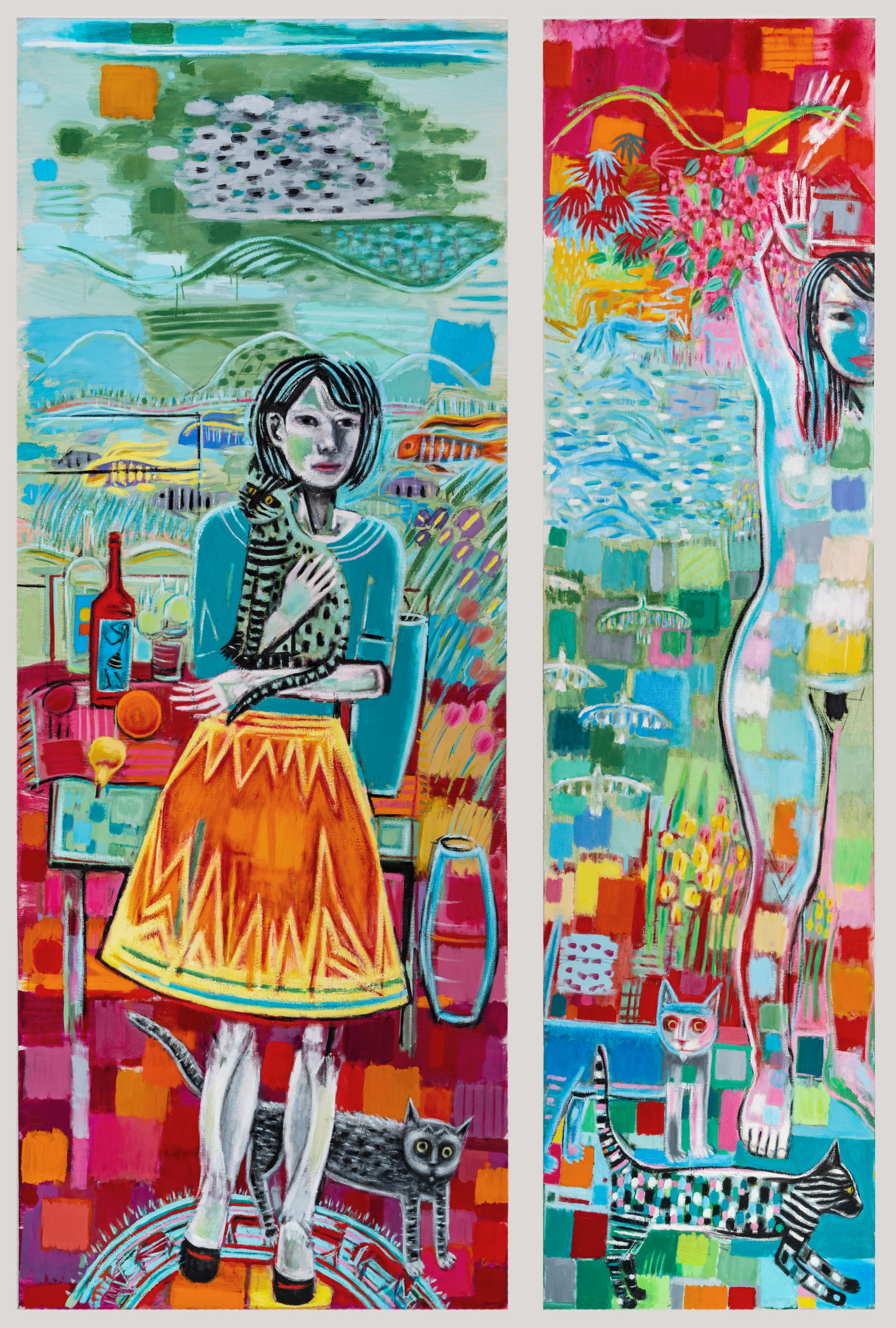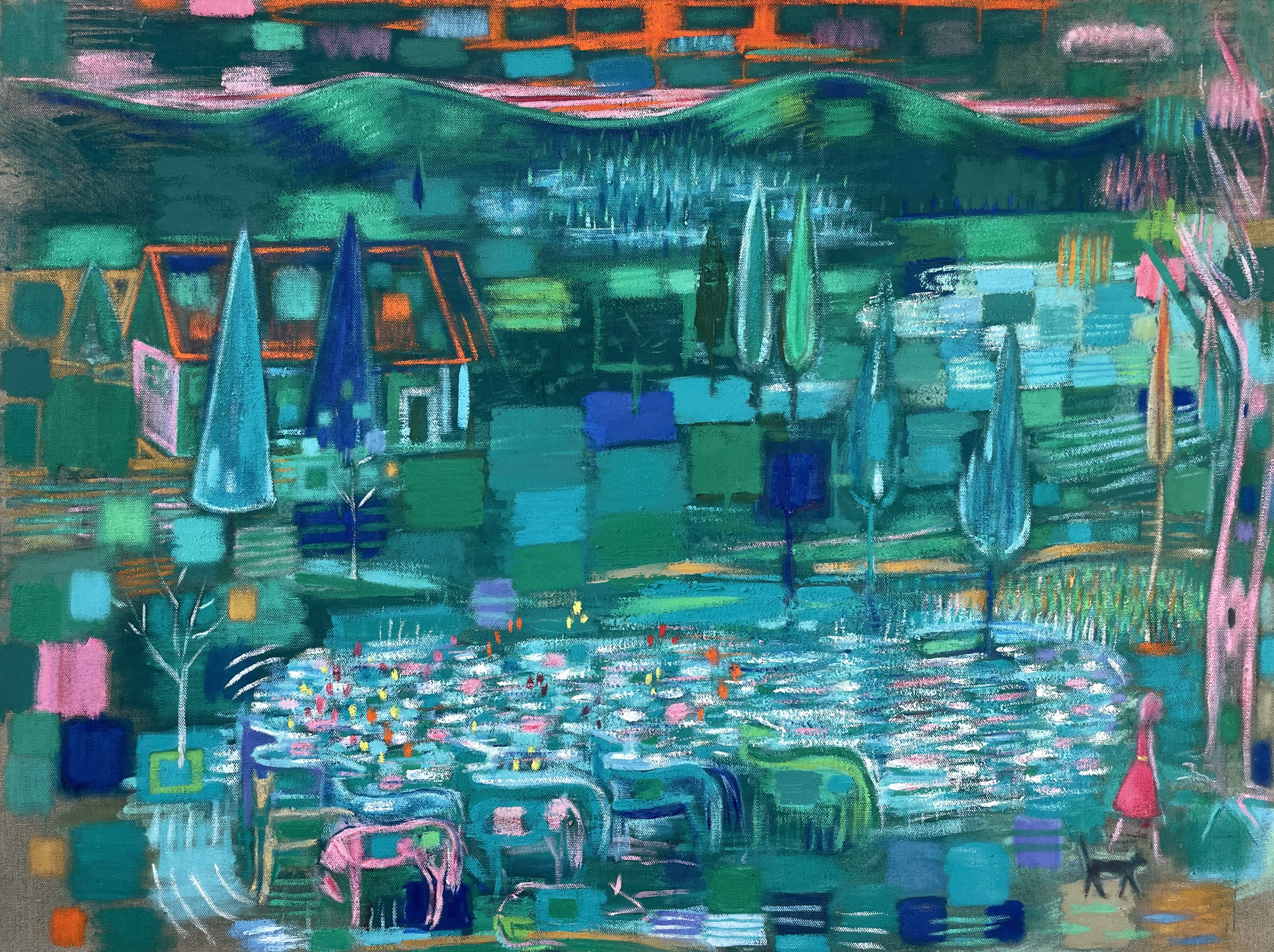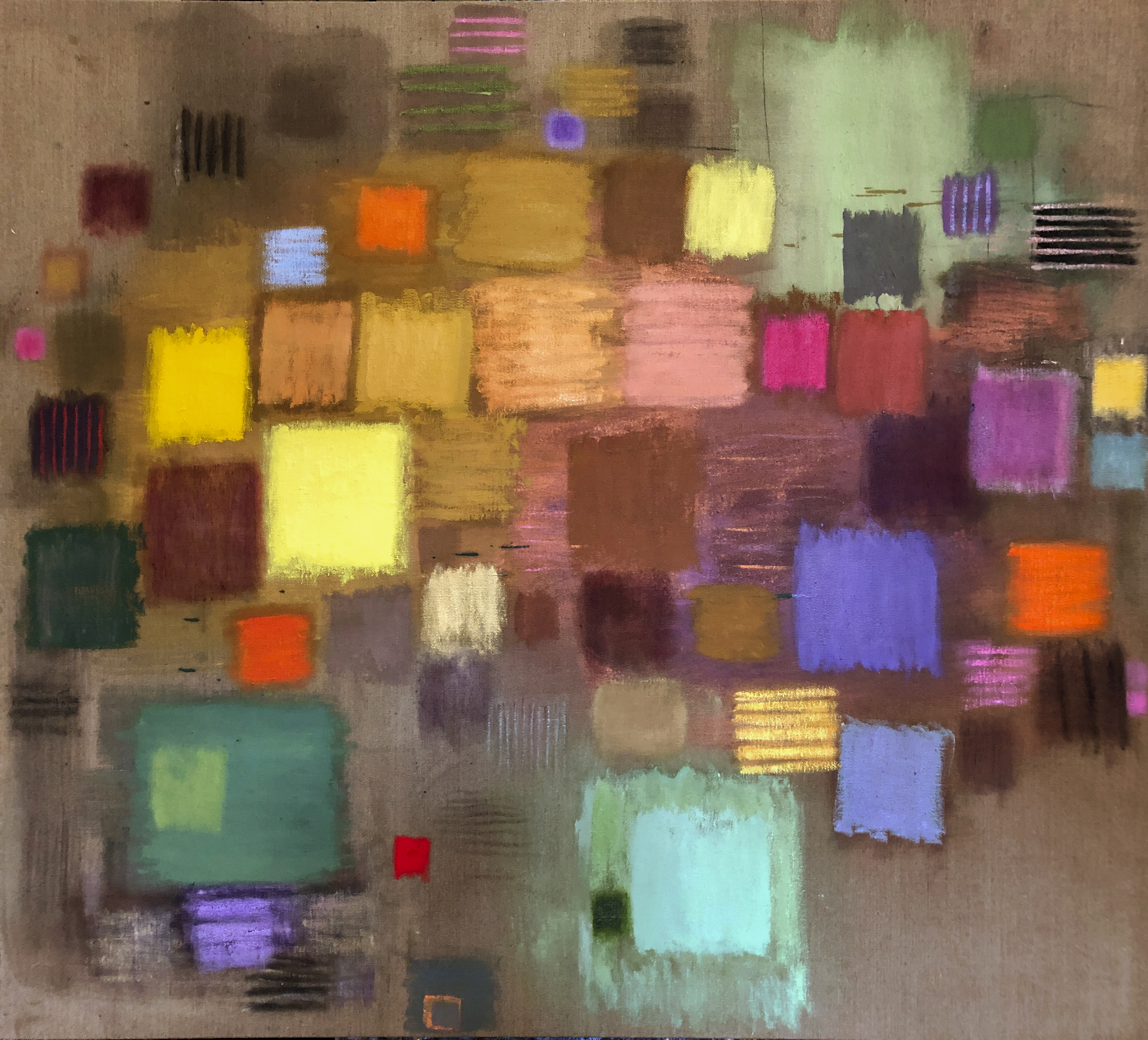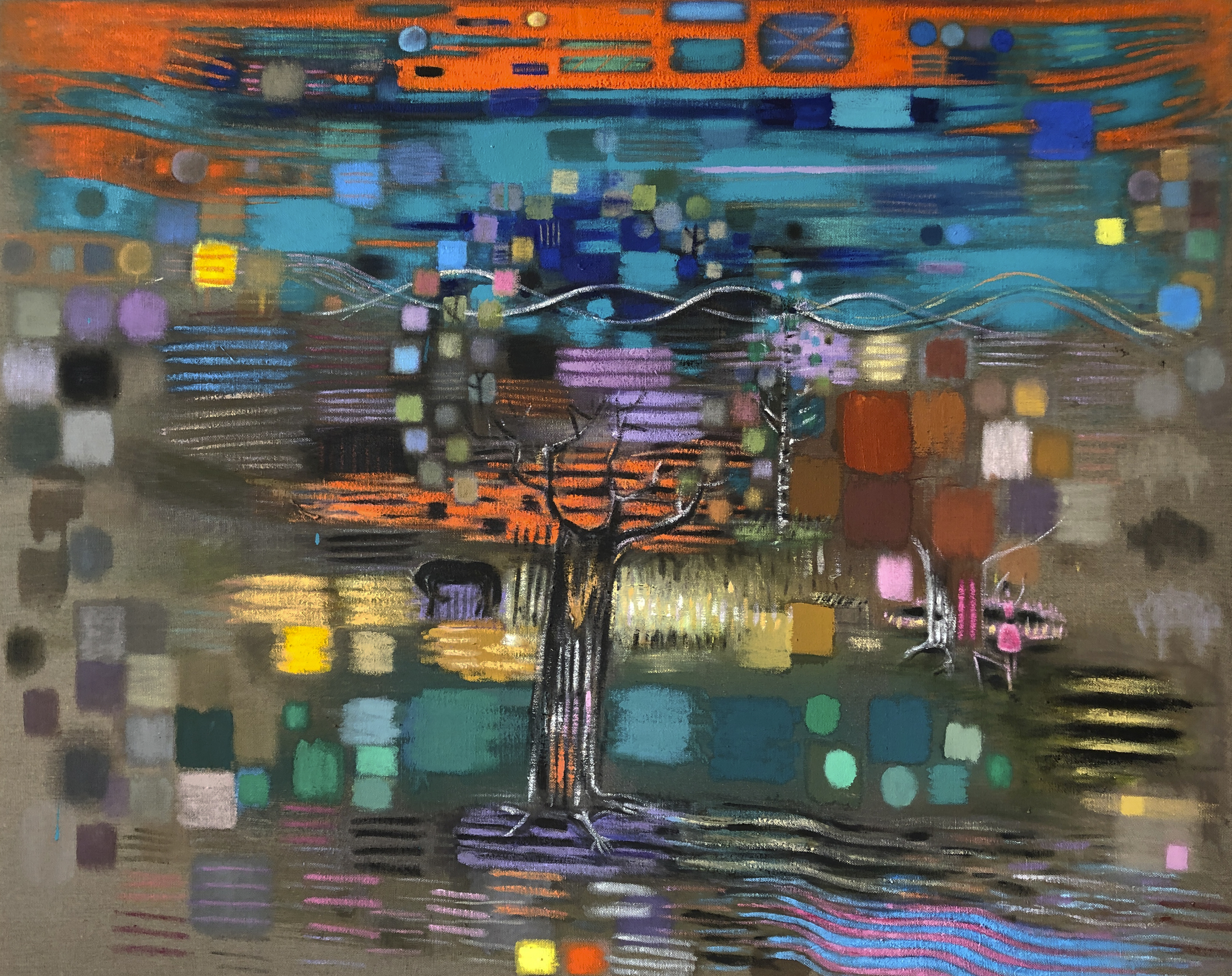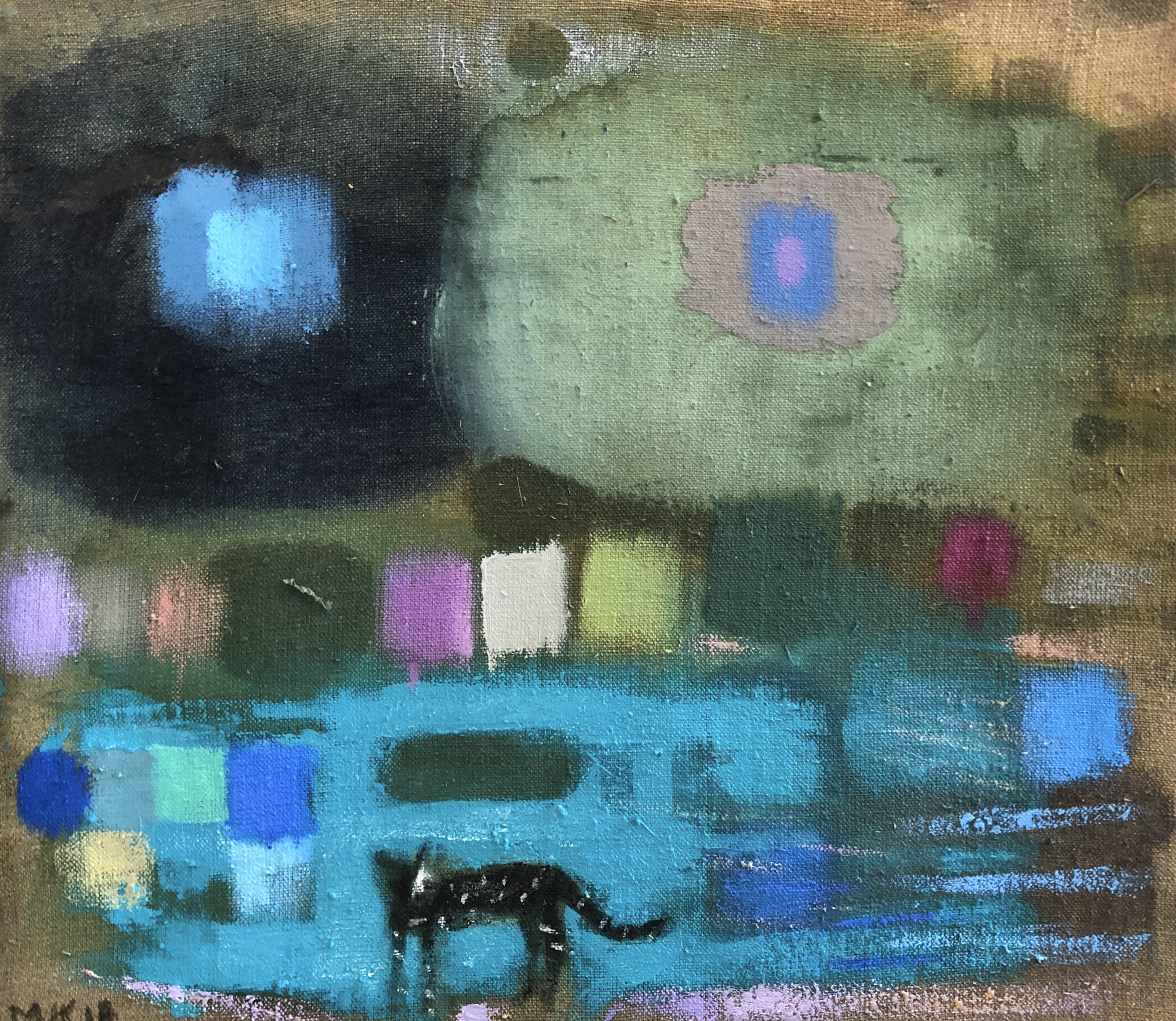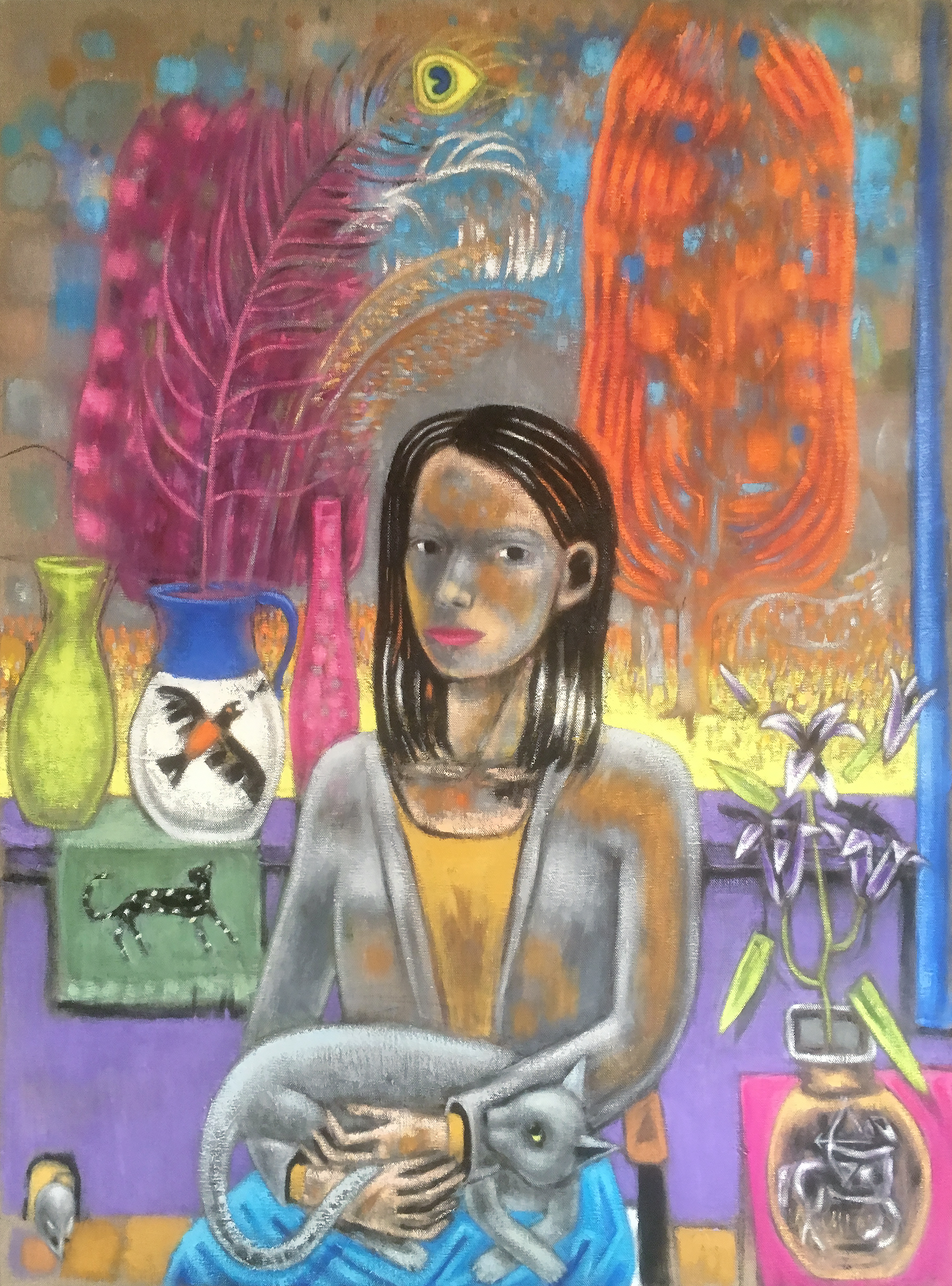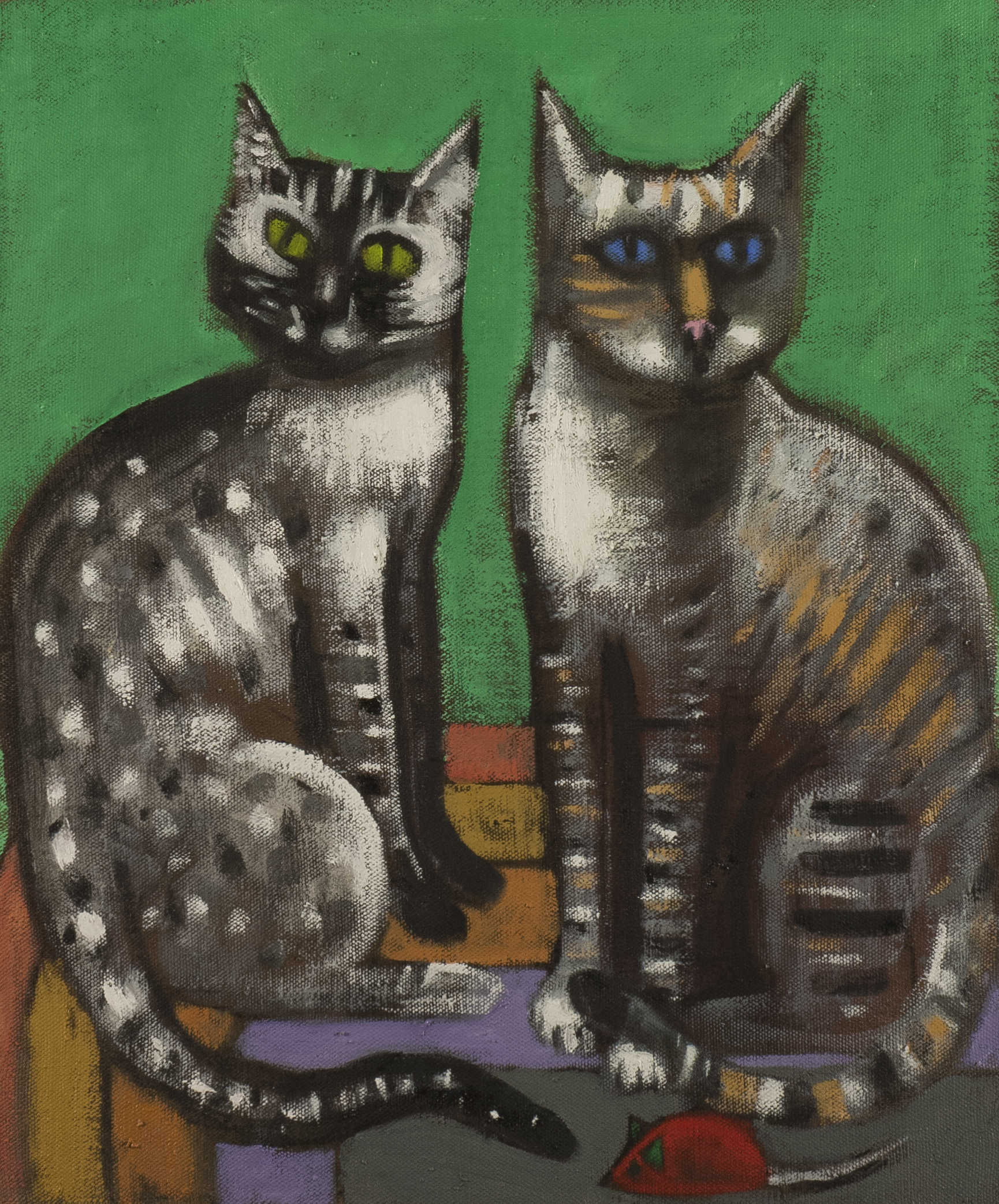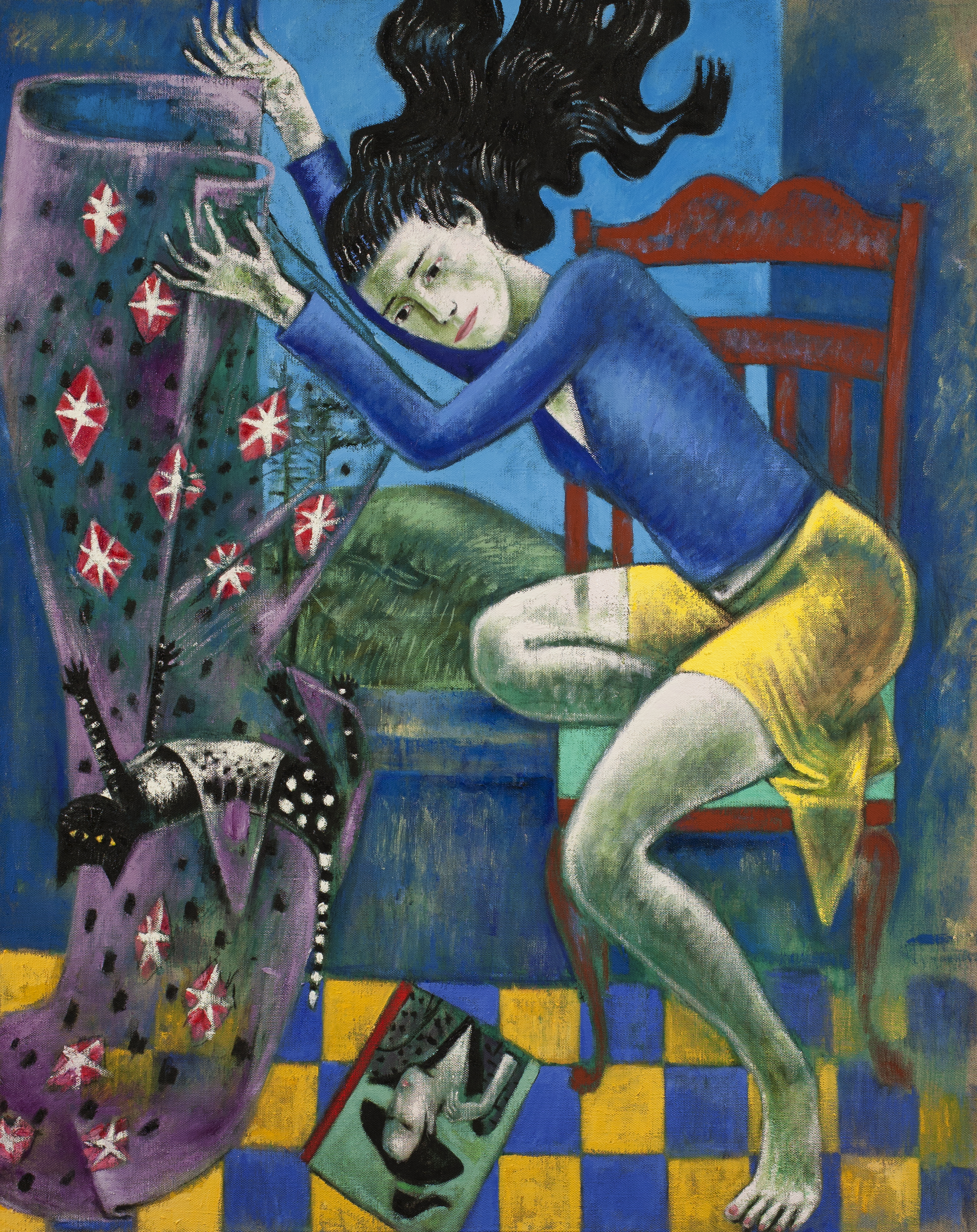The Fifteen Best Art Shows of 2023
Jersey City Times, December 10, 2023
By: Tris McCall
Click for full article
Jersey City Times, December 10, 2023
By: Tris McCall
Click for full article
The high point of the season, though, was an exhibition of startling, psychologically complicated paintings in oil and distemper by Jersey City artist Mark Kurdziel. Kurdziel’s images of women, cats, roofs, and mouse holes asked nagging questions about the permeability of domestic space and the psychological malleability of their inhabitants. They were also startling to behold: full of radiant fields of red, yellow, and rhododendron pink, all flashing through the gloom of a grey day.
The Wonders of the Powerhouse Arts District in Four New Shows
Jersey City Times, March 24, 2023
By: Tris McCall
Click for full article
Jersey City Times, March 24, 2023
By: Tris McCall
Click for full article
All the illumination in Kurdziel’s work is suggestive, but there’s plenty of it. The painter commits oil and distemper to rough-woven linen in a manner that captures the dynamics of radiance. He’ll surround a brilliant spot or square with a halo of faded color, heightening the intensity of his hot pinks, electric blues, and Gatorade-bright chartreuses by letting the field of pigment melt into the rest of the canvas. Kurtziel’s technique gives his work a Lite Brite effect: stripes on a sweater, wine in a glass, lipsticked lips, and the petals of flowers shine out from his paintings in glorious bunches.
The painter uses his command over color and shape to set strange scenes that stop just at the pulsing border of the surreal. There’s usually a woman, and she’s often the possessor of a cat. If Kurdziel’s female characters are alert and intelligent looking, his feline ones are positively brimming with alacrity. In “Fall,” a lap cat shoots a quizzical look up to the girl holding it; her face is impassive, but her hooked fingers pressing against the cat’s haunches suggests proprietary defensiveness. “Hiromi, Layla and Blu,” a seven-foot reverie that occupies the entire north wall of the gallery, confronts the viewer with a pair of cats. One lurks behind the head of an impassive woman, while the other stares fiercely outward from the middle of her torso.
The roster of residents of “The Yellow House” include another couple of cats, one of whom is as alert and angular as a pointed terrier and another who sinks into a blue blanket in a worried crouch. Mice are at play in some of these paintings, but their traditional adversaries aren’t paying any attention. They’ve got heavier responsibilities — ones that include the amplification of the emotional states of their owners.
The mouse holes in “The Yellow House” and other Mark Kurdziel paintings nag at the viewer’s eye like a loose thread on a sweater.
They’re there to raise the stakes, and suggest that the domestic sphere is more permeable than it sometimes feels like it is. The outdoors is breaking in, and the indoors is bleeding out. In many of Kurdziel’s pieces, the borders of a house appear to be dissolving in a storm of color. House plants bend toward the sky, and trees peek under triangular shapes suggestive of roofs. Are these psychological portraits of women in a transient state, keeping outwardly cool in an unstable world as security buckles around them? Or are they queens, in command of more than the eye can see?
An Artist Described by Renoir
Gallery & Studio arts journal, Spring 2022
By: Marina Hadley
Click for full article
Gallery & Studio arts journal, Spring 2022
By: Marina Hadley
Click for full article
When the famous French Impressionist Auguste Pierre Renoir called artists “pleasure givers,” he must have been looking into the future to describe Mark Kurdziel and his paintings.
Kurdziel’s colors grab your attention initially, followed by familiar motifs and forms, and then you are ensnared by his perspectives and depth of emotion. His style is very much his own, easily recognizable as his and cannot be shoe-horned into any particular artistic category. However, if pressed, he may suggest Symbolism. The subject matter of his paintings is his life.
He is first and foremost a master of color, understanding the technicalities of hue, brightness and saturation, the power of color combinations and the psychology they imbue. He understands color academically as well as practically, able to make the colors sing from his paintings and drawings. It is something that he diligently teaches his students at the Fashion Institute of Technology (FIT), where he is an adjunct professor of Fine Art.
A former student of FIT himself, he benefited from many great teachers who “vomited great quantities” of information about art and painting. During and after college, he was fortunate to meet many talented painters and teachers who would happily spend time with younger artists such as himself, to talk, critique and encourage them. Peter Heineman, a teacher at SVA —the School of Visual Arts— who studied under Joseph Albers, was one such artist who spent time with Kurdziel allowing him to “absorb the knowledge of Albers osmotically.” Another was Paul Georges, who studied with Hoffman and Ferdinand Leger, who was extremely generous with information and great at dissecting paintings when he came for an enlightening studio visit. He met Leon Polk Smith who created geometrical abstract work, Larry Rivers, sometimes called the godfather of Pop Art, Richard Pitts who was painting figurative work at the time, Don Perlis the “old master at 28,” and many others, kicking around ideas and learning all the time while they shared a drink or two."
The Dream, the Reality
Excerpt from Design New Jersey Magazine, August/September issue 2014
By: John Zeaman
Excerpt from Design New Jersey Magazine, August/September issue 2014
By: John Zeaman
These are highly personal pictures. They take the viewer into the artist’s mind with all the messy or charged content that that implies. And that is the paradox of Kurdziel’s sophistication. He sells work to designers. But for all his knowledge about how they think, his paintings are far from passive, unwilling to play background to a sofa.
'I once had a woman look at my paintings and say they were too active for her house. I told her I’d spent the past 30 years of my life trying to make active paintings.' He laughs. 'I have a tremendous amount of respect for what interior designers do. It’s not easy to put this art into someone else’s space. Real art is strong, and sometimes it can be overwhelming.'
So it was for an architect who came to Kurdziel’s studio. 'He found the paintings too bright, too colorful,' Kurdziel recalls. 'He was poking around my studio and found sketches from the two-minute poses at life drawing. He took them and had them framed. I wouldn’t have even thought of it.'
There’s a prejudice among designers in favor of horizontal paintings because they fit so well over couches. 'People will ask why a certain painting is not horizontal. I made a picture, Echo and Narcissus, that is vertical. That’s how the composition evolved. When I start a picture, I’m not thinking of whether it will be more sellable if it’s horizontal,' he says. 'At the same time, I know that houses have limitations. You’re not going to sell a giant painting for a home in Japan.'
In his role as a teacher, Kurdziel gets to mold young minds. 'One reason I enjoy teaching interior design majors is because they grow up and sell paintings. I can give them a sense of what I think quality is. Then they can take these ideas out into the world.
Place and Pattern Peopled by Women
November 2010
By: Xu Xi
Author of: That Man in Our Lives, Access, The Unwalled City, et al.
November 2010
By: Xu Xi
Author of: That Man in Our Lives, Access, The Unwalled City, et al.
The longer you gaze at Mark Kurdziel’s oeuvre – especially over time – the more you are struck by the defining force in his work of the female figure in all her manifestations. And the women are beautiful, of course, and moody or mysterious, playful or pensive, sexy, sensual, sleepy, awake, alert, alive, abundantly alive and oh so very real! You know these women: they are your sisters, daughters, mothers, wives, lovers, girlfriends, confidantes, rivals, nemeses, sirens, mona lisas and goddesses divine.
An occasional feline intrudes, and, she, because you cannot help but see a female cat, is just as urgent a manifestation of this same force.
The prevalence of place is never merely background. Instead, domestic place argues with existence and nature’s landscapes invade the periphery of conscious space. In one image here, a mouse irritates the drowsy cat, which may or may not pounce; fish do likewise to the hungry one elsewhere in his work. Things escape over boundaries, teasing the eye to break through with them to that great beyond. And if nature colors a dreamscape, it is also landscape constantly arranging and re-arranging itself into myriad patterns, a perpetual challenge to the senses.
It is pattern you always return to because pattern engaged you from the very start, from that first moment of entry into Kurdziel’s painterly world. Jigsaws of geometry, collations of colors. And as with his female figures, the excitement is experienced as much in symmetry as in the seductive breaks in form. Pattern is never predictable, but it provides entry and re-entry each time you gaze again on these tenderly gorgeous oils of his luscious nods to the history of art, the history of womanhood, the history of our very existence.
Mark Kurdziel offers us the subtle nuances of an abstracted landscape of colors and forms that merge in a nearly mystic fashion. A colorist of genuine achievement, the artist mixes and matches blues and greens and reds in a continuously fluid motion, the hues complementing each other across the expanse of the canvas. In Landscape #1, a thick green stripe outlines two hills, above which float two blue shapes, one organic and cloud like, the other more resolutely squared. The middle of the painting is taken up with reddish forms, with a horse and a stand of trees occupying the lower middle of the painting. The landscape triumphantly celebrates the joys of nature, in a way that underscores the transparent light emanating from the hills and skies he is describing. Another painting, Lost in Juarez, is replete with square and rectangular patches of color that abut and overlap each other in a way that reminds the viewer of Hans Hofmann. The painting's abstract sequences are undercut by the presence of several trees, which remind us tat this is a painting about a place as much as it s about painting itself.
Review by Desmond Barry
Author of: The Chivalry of Crime, A Bloody Good Friday, and Cressida's Bed, et al.
Author of: The Chivalry of Crime, A Bloody Good Friday, and Cressida's Bed, et al.
Mark Kurdziel's new paintings reveal the mythological in the ordinary: a party, a fish tank, a domestic cat. His women are hieratic. The flatness of their appearance on the canvas makes them Egyptian goddesses, or Greek Kouroi, or the formal erotic shapes of the sculptures of Khajuraho. These women are his link with the past- his own painterly past and the roots of painting. But just in case you thought to get too serious, there's a touch of Fat Freddie's Cat sniffing in the old fish store: mischief amongst the mystery. The ruling goddess is desire. Like all of Mark Kurdziel's unique work, the imagist language is his own while being deeply rooted in painterly traditions from the papyri through abstract expressionism. Mark Kurdziel is an American painter true to global roots. This current show is a step into territory that combines the traditional and the contemporary in a way that acknowledges the alienation of the modern without loosing touch with the richness of the past. This is powerful work.
Excerpt from Art News Magazine
By: Arlene McKanic
Click for full article
By: Arlene McKanic
Click for full article
. . . Mark Kurdziel's vibrant, semiabstractions . . . large, crowded, colorful oils recalled a happy Frankenthaler. One has to look carefully to find the feline in his Cat in Landscape (2004), so cleverly are the cat's stripes and checks integrated into the background.
Review by Judd Tully
Freelance journalist, art critic, and author of Red Grooms and Ruckus Manhattan, et al.
Freelance journalist, art critic, and author of Red Grooms and Ruckus Manhattan, et al.
Kurdziel's Fauve-like explosions of color are tamped down in other works to allow a darker, more meditative mood. In the same way, his highly stylized figure paintings depart from the landscape motif with powerful portraits of women. One thinks of Picasso's rogue's gallery of beautiful women, the Olga Koklovas, Dora Maars and Marie-Therese Walters that he painted multiple times over many decades. It would appear that several women have served as the muse for Kurdziel, who also plays on this somewhat too familiar theme (of artist and muse). He pulls it off, again, by distilling the obvious. The standing woman delicately holding the small bouquet of roses in front of her chest is ghost-like, almost an apparition. Her slim arms and long neck reinforce the impression of a dancer about to execute a pirouette, caught in the brief second of intense concentration. The effect is dream-like and the only "solid" object are the roses, all the more brilliant against her white chamisol. The background is totally abstract, with beautiful passages of lozenge-like color swatches oscillating in the distance. Penimento-like objects struggle to break through to the surface, reinforcing the ghostly presence of this mysterious woman. From small format intimate studies to the grandly scaled, Kurdziel's jazzy compositions of the landscape and the figure weave in and out of focus, offering a lush repast, ripe for the long and leisurely viewing.



